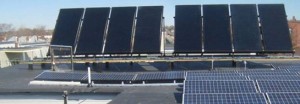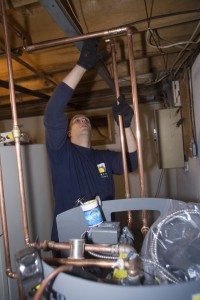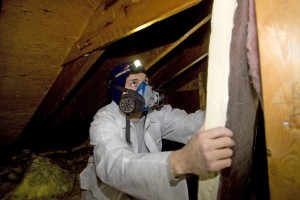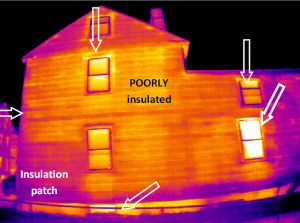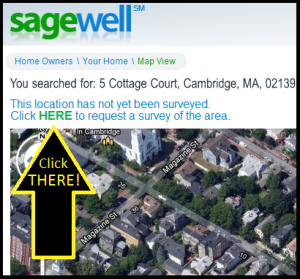This is a guest post from Eric Grunebaum from the great blog, EnergySage.
—————————————————————
 Part 1
Part 1
Search for the Solar Grail
Hello to new EnergySagers –
I’m located in Massachusetts and I thought my recent experiences looking into solar PV for my house might be helpful for folks.
First off, I should say that I’m pretty lucky to have an unobstructed south-facing roof. I’ve been thinking about solar for a while, and watching prices go down, so a couple of months ago I started asking people who had installed solar PV panels if they could recommend companies. I found two through word of mouth and then I found three more via EnergySage.com.
I was definitely interested in the “social” benefits of cutting back on fossil-fuel generated electricity, but what really surprised me is just how financially beneficial the project might be. It turns out that all of those other benefits of cutting back on fossil and nuclear generated power—reducing the massive health, economic, balance of trade and national security costs (not to mention the environmental risks of climate disturbance)—are just icing on the cake.
So back to the question of finding a solar company and figuring out if it makes financial sense. It turns out that Massachusetts is an especially good place for solar right now. It starts with saving (or eliminating) electric utility bills and then there’s the 30% federal tax credit, and also MA tax credits when you build a system.
And perhaps best of all, for the foreseeable future, there are solar renewable energy credits (“SREC”s) which you can sell every year based on how much electricity you produce. To get one SREC takes 1,000 kWh of solar energy production and the value of the credits range from $285 to $523 depending on the market. So when I calculated the yearly financial benefits, I looked at a low and a high side. There is some debate about how long the state will offer SRECs but as best I can tell, the SRECs are guaranteed to continue for 10 years at a minimum value of $285 for each 1,000 kWh you produce.
As I wrote, I received several bids and I’ve included the two best options below. One important thing to keep in mind is that are a few options for paying for your system. You can buy the system outright, finance it, or lease it. Leasing has different flavors too, some of which require no money upfront. But if you pay nothing upfront you get a smaller financial return which for some people that might be the way to go. You still save some money and you (or we!) still get all of the social benefits noted above.
For me, I don’t mind paying something upfront for a bigger return in the years to come, so the lease I looked at is what they call the “pre-paid” lease where you pay it all upfront and have no monthly payments. I compared that approach with the outright purchase.
There are many other options, but I’m just including what I think are the best two approaches, and also the best two bids, so this doesn’t get too complicated:
Vendor 1 System Size: 2.15 kW| Option A: | Purchase | $7690 | Cost of installation per kW: $3.58 |
| Option B: | Pre-Pay lease | $6680 | Cost of installation per kW: $3.11 |
This comes with a 20-year warranty and is supposed to produce about 2,600 kWh – which is about 67% of my usage so my electricity bill will not go down to zero.
Either with the Pre-Pay lease or the Purchase, the savings are the same — see below. The question is why do the purchase? As far as I can tell there’s no good reason. It costs more and provides no additional benefits. Under the lease, though, if anything stops working, the company will fix it.
Electricity Savings @ .19/kWh = $489| Annual SRECs: 2.6 | Low | $741 | High | $1359 |
| Total annual return: | | $1230 | | $1848 |
Vendor 2 System Size: 3.2 kW| Option A: | Purchase | $11,170 | Cost of installation per kW: $3.49 |
| Option B: | Pre-Pay lease | $8,030 | Cost of installation per kW: $2.51 |
This also comes with good warranties: 15 years for the labor with a 20-year guaranty on the production under a lease and also a guaranty that the panels will be at least 80% efficient up until 25 years. This system is supposed to produce about: 4,000-4,400kWh, which is 100% of my usage so my electricity bill should go down to nearly zero.
Again, with either the Pre-Pay lease or the Purchase, the savings are the same — so why buy? Note that this system produces more electricity, which means it produces more SRECs and therefore more income.
Electricity Savings @ .19/kWh = $741| Annual SRECs: 4 | Low | $1140 | High | $2092 |
| Total annual return: | | $1881 | | $2833 |
The long and short of it is that you don’t have to think about this the same way you would a kitchen or bath renovation which have no financial returns. Right now, at least in MA—and maybe some other states—it’s more like a mutual fund. If I invest $7,000 or $8,000, I’ll get from $1200 to $2800 back annually. That’s an annual return of something like 18-35% if I do one of the pre-paid leases. That’s not bad for helping out the planet a little bit and honestly I don’t think you can find a mutual fund that’s nearly as good.
Part 2
10:30 AM – the doorbell rings on Martin Luther King day. It’s 12 degrees out and the guy at the door – in blue coveralls with the NStar logo – is from the electric utility company. Carmine – that’s his name – is here to install two “net-meters” to prep for our upcoming PhotoVoltaic installation. He explains that normal electric meters go only one direction, but net-meters go forwards and backwards as well.
In the last few weeks we’ve signed all of the paperwork and so we’re on our way to an early February installation date with our PV vendor who beat out four other bidders. If you saw my prior post, we went with “Vendor 2” which – drum-roll please – is Independent Power systems. Based in Boulder, Colorado with branches in Massachusetts and Montana, they offered the best price per kW of capacity and are using SunPower panels, some of the most efficient on the market. This means we can install more panels and produce more electricity. And that means we’ll make more money selling the SRECs and save more on our electricity bills. IPS was also the only company that took the time look inside the attic crawlspace at the roof structure and then clambered up on the roof to get exact measurements. IPS went the extra mile and consulting with EnergySage.com confirmed my review of all the numbers.
And about all that paperwork – there was a fair amount of it with all of the incentives and credits and companies involved. It’s something the industry should definitely try to streamline, but all told, it probably took no more than a few hours of work, even factoring in that I actually read every one of the 26 pages in the pre-paid lease contract.
So today the utility is getting its ducks lined up too. All of those documents and notifications have led NStar to my door. What I still find amazing, though, is that the electric utility which makes money by selling electricity is actually helping me to buy less electricity. I’d be remiss if I didn’t applaud the enlightened utility regulation which rewards them for saving electricity and not just for building new power plants. Sometimes this is referred to as selling “negawatts.” To paraphrase Ben Franklin, a power plant saved is a power plant earned.
And here’s how it works with our utility: those net-meters meters will give us credit for all of the electricity we generate on our roof. And when we’re making more than we’re using, the meter will run backwards, effectively storing up credit for us to use at night or on a rainy day. If our system is in balance, as our installer predicts, each year we should produce almost exactly what we use, and our bill will be a very amount of under $10 month for use of the transmission lines. At the end of the year, if we generate more than we use, although we can’t sell it, we can give the “extra” electricity credit to a relative or friend.
The thought that we will soon break a small link in the energy monopoly and help build a new distributed generation economy is appealing. There are many people today who say we cannot possibly run the world without fossil fuels. Yet the evidence tells us otherwise. There are more jobs in renewables and efficiency, and most of them cannot be “off-shored.” And when the cost of renewables is nearly on par with fossil fuels then we can see that the world is changing. We are truly at an inflection point and as Richard Branson’s Independent Power systemsCarbon War Room puts it, “Over 50% of the climate change challenge can be addressed today – and profitably – by existing technologies, under existing policy. This is an opportunity marked as a crisis – arguably the largest wealth creation opportunity of our lifetime.”
And if we actually priced coal and oil properly, with all of the hidden costs to society factored in, then the benefits of cutting fossil fuel use would be even more starkly defined.
Maybe because it was Martin Luther King Day I was reminded of a quote from another civil rights pioneer, Bobby Kennedy. Kennedy spoke about sending forth a “tiny ripple of hope” which would cross with “a million different centers of energy” to grow in strength and change the world. Our solar panels may only be a single installation, but they have the potential to inspire many more, and gradually we will wean ourselves from a dependence on fuels which harm our health and the planet.
Best of all, we can do this not only because we will leave our children a better planet, but also because it can save us some serious money while we’re here.
Eric Grunebaum
Cambridge, MA

